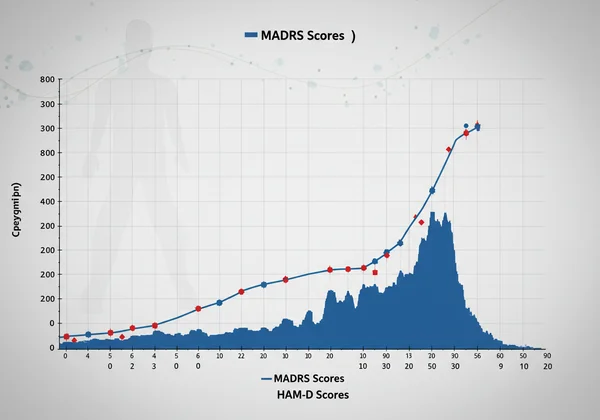MADRS Validity & Reliability: Science Behind the Gold Standard
For anyone involved in mental health assessment—clinicians, researchers, or individuals seeking personal insight—the accuracy and trustworthiness of diagnostic tools are paramount. That's why instruments must be scientifically sound. The Montgomery-Åsberg Depression Rating Scale (MADRS) has long been hailed as a clinical "gold standard" for evaluating the severity of depression. But what is the MADRS scale, and what scientific principles cement its esteemed reputation? This article delves into the core psychometric properties—validity and reliability—that make the MADRS a robust and indispensable instrument.
Understanding the science behind the scale is crucial for anyone using it to make informed decisions. Whether you are a healthcare professional monitoring treatment efficacy or an individual tracking your mental wellness journey, knowing that your results are based on a rigorously tested framework provides confidence. Here, we will explore the evidence that underpins the scale’s accuracy and consistency, demonstrating why it remains a cornerstone of depression assessment. To see this gold-standard tool in action, you can take the MADRS test on our platform.

Understanding MADRS Validity: Does it Measure What it Claims?
The cornerstone of any credible psychometric tool is validity. In simple terms, validity answers the fundamental question: Does the test accurately measure the concept it is designed to assess? For the MADRS, this means confirming that it truly captures the core symptoms and severity of depression. Strong MADRS validity is not a single feature but is established through several distinct types of evidence.
Content Validity: Ensuring Comprehensive Symptom Coverage
Content validity ensures that the test items comprehensively cover all relevant aspects of the condition being measured. The MADRS excels in this area by focusing on the core psychic symptoms of depression, such as sadness, inner tension, and pessimistic thoughts, which are often less responsive to placebo effects. Its 10 questions were carefully selected by its creators, Montgomery and Åsberg, to provide a sensitive measure of change, particularly during treatment. This targeted approach ensures that the scale isn't just a generic checklist but a precise instrument for gauging the central features of a depressive episode. This focus provides a deep and relevant picture of an individual's mental state, making the online MADRS assessment a powerful tool.
Criterion Validity: Comparing MADRS to Established Measures
Criterion validity evaluates how well a test's results correlate with an external, established benchmark or "criterion." The MADRS has been extensively studied and shows a strong correlation with other highly regarded depression scales, most notably the Hamilton Depression Rating Scale (HAM-D). Numerous studies have demonstrated that MADRS scores align closely with HAM-D scores, confirming that both scales are measuring a similar underlying construct. However, the MADRS is often favored for its superior sensitivity in detecting changes in symptoms over time, making it particularly useful in clinical trials and for monitoring treatment progress. This proven alignment with other gold-standard tools reinforces the trustworthiness of the results you receive from our clinically trusted tool.

Construct Validity: The Theoretical Framework Behind the Scores
Construct validity is arguably the most essential form of validity, assessing whether a test truly measures the theoretical concept it's supposed to. It examines the underlying structure of the scale to ensure its items logically relate to the broader theory of depression. The MADRS demonstrates strong construct validity because its 10 items consistently group together to measure a single, unified concept: depression severity. Factor analysis studies have repeatedly shown that the scale's questions effectively tap into the core dimensions of depression, from mood and ideation to vegetative symptoms, confirming that the total score provides a meaningful and cohesive representation of the illness.
Ensuring MADRS Reliability: Consistent & Stable Assessment Scores
Another critical pillar supporting the MADRS is reliability. Reliability refers to the consistency and stability of a measurement tool. If a scale is reliable, it will produce similar results under consistent conditions. High MADRS reliability means that clinicians and users can trust that the score reflects the individual's actual state, not random error or fluctuations in the assessment process. This consistency is vital for tracking changes accurately over time.
Inter-Rater Reliability: Agreement Among Clinicians Using MADRS
Inter-rater reliability measures the degree of agreement between different raters or administrators of a test. For a clinical scale like the MADRS, this is crucial. Studies have consistently shown that when different trained clinicians interview the same patient, they arrive at very similar MADRS scores. This high level of agreement is facilitated by the scale's clear, semi-structured interview guide and well-defined anchor points for each level of severity on its 0-6 point scale. This ensures that a score is not dependent on who is conducting the assessment, making it a reliable tool across different clinical settings.

Test-Retest Reliability: Stability of MADRS Scores Over Time
Test-retest reliability assesses the stability of a test over a short period when the underlying condition is not expected to change. If a patient with stable depression is assessed with the MADRS on two separate occasions close in time, their scores should be very similar. The MADRS has demonstrated excellent test-retest reliability, confirming that it provides a stable measure of depressive symptoms. This stability is fundamental for its use in longitudinal tracking, as it gives professionals confidence that any observed changes in the score are due to genuine clinical improvement or worsening, rather than inconsistencies in the test itself. You can begin tracking your progress by using the tool on our platform.
Internal Consistency: Cohesion of MADRS Scale Questions
Internal consistency refers to how well the different items on a scale work together to measure the same underlying construct. If a scale has high internal consistency, its questions are all contributing to the overall score in a cohesive way. The MADRS consistently shows high internal consistency, often measured using a statistic called Cronbach's alpha. This indicates that all 10 items are effectively measuring different facets of the same core concept—depression. This cohesion ensures that the total MADRS score is a unified and powerful summary of a person's symptomatic state.
The Psychometric Journey: From Development to "Gold Standard"
The scientific rigor of the MADRS is not accidental; it is the result of meticulous design and decades of empirical validation. Understanding its journey from development to its current status helps solidify why it is such a trusted instrument in mental health.
Development and Evolution of the Montgomery-Åsberg Depression Rating Scale
Developed in the late 1970s by Stuart Montgomery and Marie Åsberg, the MADRS was specifically designed to be more sensitive to the effects of antidepressant medication than existing scales. Its creators focused on core psychological symptoms that were less likely to be influenced by placebo effects or the sedative side effects of older medications. This intentional design choice is a key reason for its enduring relevance and widespread adoption in both clinical practice and pharmaceutical research.
Why MADRS Remains a Clinical "Gold Standard"
The MADRS remains a "gold standard" because its strong psychometric properties—high validity and reliability—have been proven time and again in hundreds of studies across diverse populations. Its sensitivity to change makes it an unparalleled tool for monitoring treatment outcomes. Furthermore, its focus on key symptoms and efficient 10-item structure makes it practical for busy clinical environments. This blend of scientific robustness and clinical utility is why it continues to be the scale of choice for professionals worldwide who need to understand their patient's score.
Distinguishing MADRS: A Comparative Look at Other Depression Scales
While other scales like the Patient Health Questionnaire-9 (PHQ-9) or the Beck Depression Inventory (BDI) are valuable, the MADRS occupies a unique position. It is clinician-administered (though self-report versions are used for screening), allowing for nuanced clinical judgment. Its primary strength lies in its sensitivity to change, making it superior for tracking treatment response compared to many self-report questionnaires. This is why professionals often turn to the MADRS for detailed monitoring after an initial diagnosis.

Trusting the Numbers: The Enduring Scientific Basis of MADRS
The Montgomery-Åsberg Depression Rating Scale is more than just a questionnaire; it is a scientifically validated instrument built on a foundation of robust validity and reliability. Its comprehensive symptom coverage, strong correlation with other established measures, and consistent performance across raters and time points are what elevate it to a "gold standard." This scientific backing ensures that every score provides meaningful, accurate, and actionable insight into depression severity.
On our platform, we provide a clinically trusted digital version of this powerful tool, making it accessible for professional monitoring and personal insight. By understanding the science, you can feel confident in the results. Ready to leverage a tool backed by decades of research? Explore the scale on our homepage today to begin your assessment.
Frequently Asked Questions About MADRS Psychometric Properties
1. What is the MADRS scale, and why is its science important?
The MADRS is a 10-item diagnostic questionnaire used by clinicians to measure the severity of depressive episodes. The science behind it, specifically its proven validity and reliability, is crucial because it ensures the scores are accurate, consistent, and truly reflective of a person's condition. This allows for confident diagnosis, effective treatment monitoring, and reliable research outcomes.
2. How accurate is the MADRS in assessing depression severity?
The MADRS is considered highly accurate. Its strong criterion validity shows it correlates well with other gold-standard depression assessments, while its content validity confirms it covers the most critical symptoms. Its scientific backing makes it one of the most trusted tools for accurately measuring the severity of depression. You can access a free MADRS assessment on our site to see how it works.
3. Are the 10 MADRS questions consistent in their measurement?
Yes, the questions demonstrate high internal consistency. This means all 10 items work together cohesively to measure the underlying construct of depression. This ensures that the total score is a meaningful and unified summary of a person's symptoms.
4. How does the MADRS ensure consistent results across different clinicians?
The MADRS achieves high inter-rater reliability through its clear scoring guidelines and well-defined anchor points for each question. This structured approach minimizes subjective interpretation, ensuring that different trained clinicians evaluating the same individual will arrive at very similar scores, making the results dependable regardless of the administrator.
5. Can the MADRS be used for self-assessment, given its scientific backing?
While the original MADRS is a clinician-administered tool, self-report versions are widely used for screening and monitoring. The scientific rigor behind the scale means that even in a self-assessment format, it provides valuable and structured insight into your symptoms. However, it's crucial to remember that it is an assessment tool, not a diagnostic one. Always discuss your results from any MADRS online test with a healthcare professional.